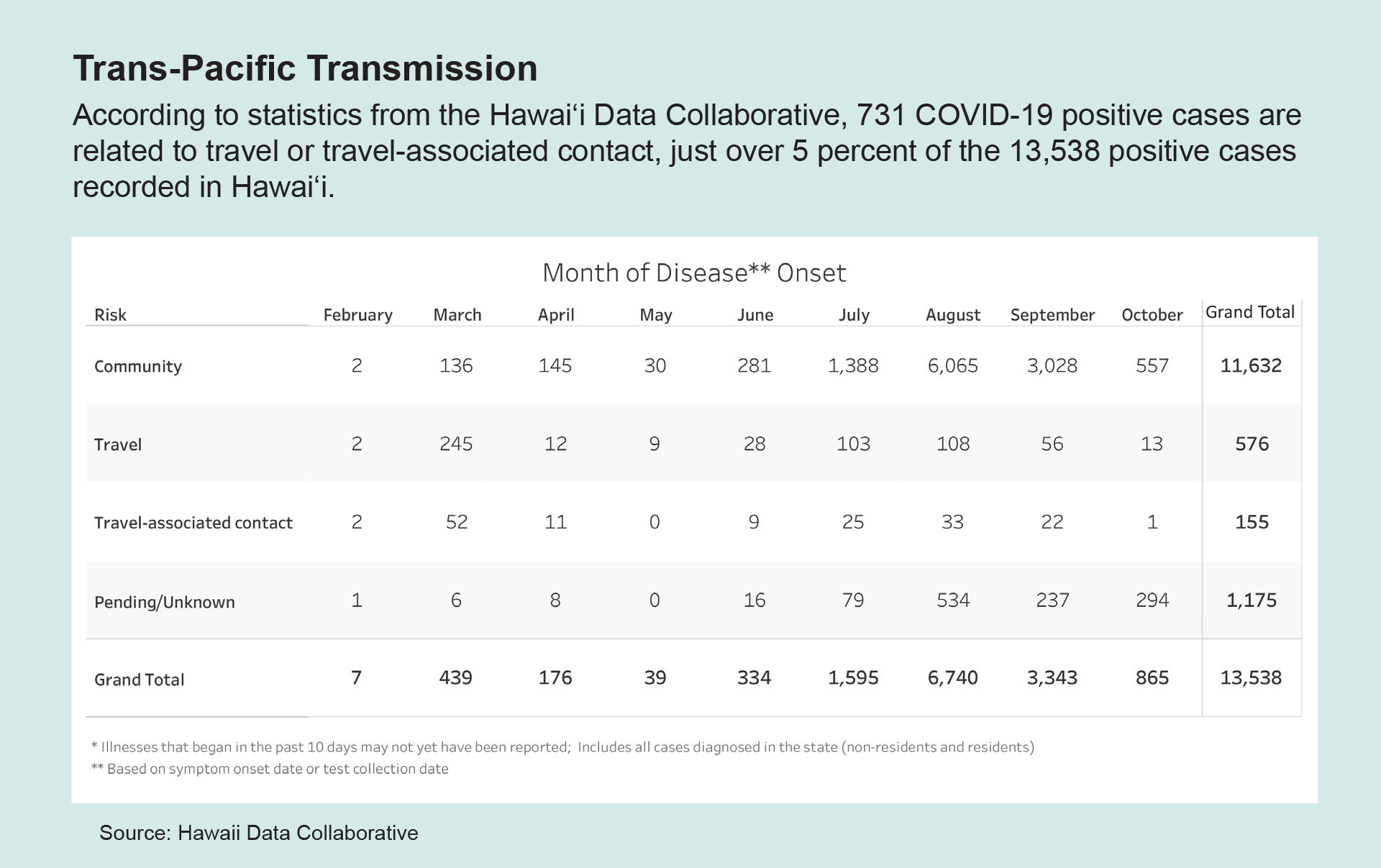20-13, Limited Scope Review of the State of Hawai‘i’s Mandatory Travel Self-Quarantine Program
Posted on Oct 14, 2020 in Summary
As a novel coronavirus ravaged regions in Asia, Europe, and the continental United States, the State of Hawai‘i took an unprecedented step to prevent the virus that causes COVID-19 from spreading in the Islands. Since March 26, all travelers entering the state – visitors and returning residents alike – have been required to self-quarantine for 14 days upon arrival, with limited exceptions. According to the Director of the Hawai‘i Emergency Management Agency, who is appointed by the Governor to serve as the Incident Commander for COVID-19, the self-quarantine mandate was meant to deter visitor traffic as well as restrict the mobility of those who do travel to Hawai‘i during the period they might be contagious. The effect on travel was immediate – April 2020 arrivals were down 99 percent from a year earlier and have remained at depressed levels since.
The travel self-quarantine program has evolved over the past six months and is on the cusp of yet another major change; effective October 15, a new pre-travel testing program will allow visitors to bypass self-quarantine with proof of negative results from a state-approved COVID-19 testing partner within 72 hours of flying to Hawai‘i. Yet two days before the pre-travel testing program was set to be launched, details of how it will work – particularly on the neighbor islands – were still unsettled. The lingering uncertainty as Hawai‘i begins reviving its tourism industry reflects many of the concerns raised in our limited scope review of the travel self-quarantine program. While we observed well-intentioned, hard-working state and county employees during our work on this report, we did find an overall lack of coordinated planning and communication among the state and county agencies involved. This has diminished the effectiveness of the self-quarantine program and raises questions about the program’s future success.
About this report
At the Senate Special Committee on COVID-19’s request, we performed a limited scope review of the travel self-quarantine program. Our report includes a high-level analysis of the airport screening process for trans-Pacific and interisland arrivals, the web-based Safe Travels program that collects travelers’ health and trip details and makes the information available to those responsible for ensuring compliance, enforcement efforts, and both near-term and long-range planning. It also offers recommendations aimed at providing oversight and improving coordination and communication among the many agencies charged with developing, operating, and enforcing the travel self-quarantine mandate.
What we observed
The travel self-quarantine program is a multiagency effort, pulling together the Department of Transportation-Airports Division (DOT-Airports), the Hawai‘i Tourism Authority (HTA), the Office of Enterprise Technology Services (ETS), the Hawai‘i Emergency Management Agency, the Hawai‘i National Guard, the Department of the Attorney General, and county law enforcement, as well as the Department of Health (DOH). While the Incident Commander is responsible for overseeing the State’s overall response to the COVID-19 pandemic, we could not identify any individual who is tasked with operational oversight over the travel quarantine component of the State’s response and familiar with all aspects of the program.
Rather, we discovered each state and county agency is generally operating in its own “silo,” focused on a specific function and not necessarily considering the big picture. For example, ETS created the web-based Safe Travels platform to expedite the airport screening process led by DOT-Airports, automate compliance checks previously performed by HTA, and help county police departments enforce the self-quarantine requirements. In practice, though, Safe Travels has not eliminated the need for airport screeners to manually verify health and trip information that passengers are required to provide on the State’s digitized health and travel form prior to departure. Automated emails and text messages that remind all people in self-quarantine to check in daily have replaced a 100-person call center that reached only 10 percent of those in quarantine. However, the automated daily check-ins are through email and soon, voice bots, but do not include location information to confirm that the person is checking in from their designated self-quarantine location.
Generally, we found information does not flow smoothly between the state and county agencies involved in different aspects of the program. While the State has led screening efforts at the airports, enforcing the travel quarantine has fallen to the counties, which have taken different approaches to ensuring compliance with the travel self-quarantine. Kaua‘i, for example, has adopted the strictest measures, conducting 300 in-person compliance checks a day with the assistance of Hawai‘i National Guard personnel and collecting traveler information on its own form instead of relying on the State’s mandatory travel and health form that collects the same information. In other counties, enforcement has been largely reactive, dependent on reports and complaints from the public, social media, and interested community groups. As a result, the self-quarantine is largely an “honor” system, dependent upon the deterrent effect of potential penalties and the visitor’s tolerance for risk.
Issues and Concerns
An absence of near-range and long-term planning raises questions about the program’s future even as the State anticipates an imminent increase in arrivals. Passenger screening, currently led by DOT-Airports and staffed by the Hawai‘i National Guard and private contractors, will be handed off to DOH at the end of the year. We found little evidence of planning for this impending transition, however, which is now less than three months away. None of the people we interviewed could even tell us how the travel self-quarantine program will be funded after the end of the year, which includes contracts with Roberts Hawaii Tours, Inc. and Worldwide Flight Services, Inc. to screen arriving trans-Pacific travelers at some of the State’s airports, as well as the counties’ costs to enforce the quarantine. Those expenses currently are paid with moneys the State received through the CARES Act, which must be spent by December 30, 2020.
According to the Incident Commander, “When [DOT-Airports] started screening, I told them that we cannot have the perfect product. However, just by announcing it and doing it, we will eliminate 90 percent of the visitors.” The travel self-quarantine mandate initially reduced visitor arrivals by 98 percent, he said, calling that “a huge success.” Nevertheless, more than six months after the travel quarantine mandate went into effect, we expected to see better communication and coordination between the agencies responsible for different aspects of the program. The program is hampered by a lack of oversight and the absence of a defined organizational structure to effectively and efficiently manage every piece of the process, starting from screening at the airports to enforcement of the quarantine requirement. Instead, the apparent delegation of authority to agencies to develop their own processes to support their responsibilities relating to the travel self-quarantine program has created inefficiencies and other concerns that likely have – and, if unaddressed, will continue to – hurt the effectiveness of the program.

